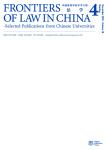RULEMAKING POSSIBILITIES: EFFORTS OF THE UNITED STATES JUDICIAL CONFERENCE ADVISORY COMMITTEE ON EVIDENCE RULES TO ADDRESS THE CHALLENGES TO FORENSIC EXPERT TESTIMONY
RULEMAKING POSSIBILITIES: EFFORTS OF THE UNITED STATES JUDICIAL CONFERENCE ADVISORY COMMITTEE ON EVIDENCE RULES TO ADDRESS THE CHALLENGES TO FORENSIC EXPERT TESTIMONY作者机构:School of Law University of California Berkeley USA Reed Professor School of Law Fordharn University New York 10023 USA
出 版 物:《Frontiers of Law in China-Selected Publications from Chinese Universities》 (中国高等学校学术文摘·法学(英文版))
年 卷 期:2018年第13卷第1期
页 面:34-42页
学科分类:12[管理学] 120202[管理学-企业管理(含:财务管理、市场营销、人力资源管理)] 0301[法学-法学] 0202[经济学-应用经济学] 02[经济学] 03[法学] 1202[管理学-工商管理] 1201[管理学-管理科学与工程(可授管理学、工学学位)] 030106[法学-诉讼法学]
主 题:forensics rulemaking reliability expert
摘 要:This piece is an echo to one of the main subjects of the Sixth International Conference on Evidence Law and Forensic Science which is to determine what evidentiary reforms are necessary for regulating forensic expert testimony, and how those reforms might be implemented. In United States, the predominant way of evidentiary reform is through rulemaking. As the Reporter of Judicial Conference Advisory Committee on the Federal Rules of Evidence since 1996, the author, with a pragmatic spirit throughout the article, examines such an effort at the federal level of U.S. in six parts (levels), starting from the most general, abstract level till fmishing with the most detailed and substantive points. Part I begins with a brief introduction of the hierarchies of evidentiary rulemaking authorities at the federal level of the United States, various interested groups and their interesting interactions in the rulemaking process. The author then shifts to the general topic of writing rules with a specific focus on the level of detail that is to be provided in doing so; Part II further narrows down the scrutiny into writing a rule on forensic expert testimony with an emphasis on the necessity of making such a rule change to the current general standards of FRE; Part III directly addresses the challenges of drafting a rule on forensic evidence in FRE, including a comparation of various alternative drafting models; Part IV and Part V respectively discusses the Reporter's comments and the Justice Department's concerns over the drafted rules; and Part VI briefly discusses the feasibility and effectiveness of a Best Practices Manual on forensic evidence in lieu of rulemaking.



